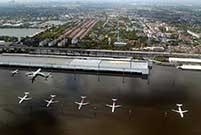

BEIJING, Dec. 29 -- China's first high orbit remote sensing satellite, Gaofen-4, was sent into space Tuesday.
Gaofen-4 is China's first geosynchronous orbit high-definition optical imaging satellite. It will be used for high-precision observation of China and its surrounding areas, and serving as the source of observation data, says Zhang Hongtai, president of China Academy of Space Technology.
According to Li Guo, chief designer of Gaofen-4, this satellite can "see" the entire area of Beijing and Tianjin at a glance. It will benefit countries and regions along the Belt and Road Initiative as well as providing services for various domestic industries.
Gaofen-4 is orbiting 36,000 kilometers away from the earth, much farther away than other remote sensing satellites which typically orbit at 500 km or at 1,000 km. High orbit satellite have the advantage of being able to snap "grand scenarios." Low orbit satellites, in contrast, can see more detail at faster speed.
Low orbit satellites cannot always follow natural disasters, but Gaofen-4 can continuously observe a disaster because it moves synchronously with the earth. It improves the response to disasters like earthquakes landslides and typhoons with its high-precision sensors.
Gaofen-4 has a designed lifespan of 8 years, compared to other remote sensing satellites which remain is service for less than 3 to 5 years.
Since the inception of the Gaofen project in 2013, China has an increasingly clearer view of the planet. Gaofen-1, launched in April 2013, could cover the globe in merely 4 days. Gaofen-2, sent into space in August 2014, is able to resolve to 0.8 m in full color and collect multispectral images of objects of 3.2 meters or longer. The two satellites enable China to be basically self-sufficient in high-definition remote sensing data.
China will launch Gaofen-3 in 2016 and accelerate the research and development of Gaofen-6 and Gaofen-7. The goal of the Gaofen series is to provide all-weather, 24-hour service covering the globe.
 Are these the world’s scariest landing strips?
Are these the world’s scariest landing strips? In pics: Left behind children in China
In pics: Left behind children in China Eight modern day engineering marvels of China
Eight modern day engineering marvels of China Chinese beauty with sexiest bottom
Chinese beauty with sexiest bottom Charming female bodybuilders of Chengdu University
Charming female bodybuilders of Chengdu University Polish sports stars strip off for risqué calendar
Polish sports stars strip off for risqué calendar Spectacular aerial photos of the Three Gorges
Spectacular aerial photos of the Three Gorges Contestants of Mrs. Globe pose for photo in Shenzhen
Contestants of Mrs. Globe pose for photo in Shenzhen
 Bikini models attend hot pot banquet in Hefei
Bikini models attend hot pot banquet in Hefei Top 20 hottest women in the world in 2014
Top 20 hottest women in the world in 2014 Top 10 hardest languages to learn
Top 10 hardest languages to learn 10 Chinese female stars with most beautiful faces
10 Chinese female stars with most beautiful faces China’s Top 10 Unique Bridges, Highways and Roads
China’s Top 10 Unique Bridges, Highways and Roads Laowai Internet sensations
Laowai Internet sensations Comfort women deal will not aid Tokyo
Comfort women deal will not aid Tokyo Parents demand air purifiers be installed in schools, not all successful
Parents demand air purifiers be installed in schools, not all successful A sign of disaffection, rural worship of Chairman Mao is treated with caution
A sign of disaffection, rural worship of Chairman Mao is treated with cautionDay|Week